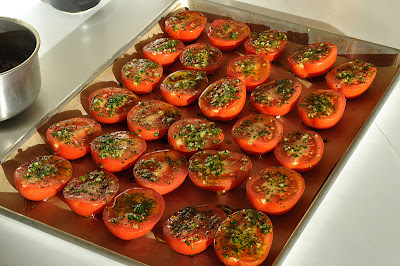Back in the days of hippiedom and the unusually earthy cuisine that grew up around it, sprouting was all the rage. And say what you may about most of said cuisine, a few things not only stuck, but joined the mainstream. Sprouting seeds for food is such an easy process, and if you're paying attention even just a little bit, quite miraculous. All you really do is soak them, drain them, and rinse and drain twice a day, and in a few short days you have a tangle of superfood tendrils. Brilliant, life is.
I had sprouted several seed varieties in my time, but for some reason I never tried lentils until recently. Then I came upon a nearly empty bag of very small tan colored lentils (an heirloom variety whose name unfortunately eludes me now), too few to bother cooking. So I decided to sprout them. They took a total of three days to reach their peak, and I seized the occasion to make a quick salad.
I wanted something that would showcase the lentil sprouts without distracting from them too much, so I picked only two vegetables to pair them with, red onion and beet. I sliced the onion thinly, grated the beet, and combined them with the sprouted lentils. I happened to have a fair amount of leftover balsamic vinaigrette in the refrigerator, so rather than start over and make a new dressing, I went ahead and tossed it into the salad. I had actually had in mind a sort of mustardy vinaigrette, but the beets played quite well with the rich 18-year old balsamic, and the resulting sweetness of the salad made a pleasant foil for the starchy-raw mouthfeel of those young lentil-lifeforms. My only possible complaint would be that I didn't have more of it.
If I manage to recall the name of those lentils, I'll definitely order them again and try a few other applications. Sprouting is fun. It's like gardening for the ADD-afflicted.
.
I had sprouted several seed varieties in my time, but for some reason I never tried lentils until recently. Then I came upon a nearly empty bag of very small tan colored lentils (an heirloom variety whose name unfortunately eludes me now), too few to bother cooking. So I decided to sprout them. They took a total of three days to reach their peak, and I seized the occasion to make a quick salad.
I wanted something that would showcase the lentil sprouts without distracting from them too much, so I picked only two vegetables to pair them with, red onion and beet. I sliced the onion thinly, grated the beet, and combined them with the sprouted lentils. I happened to have a fair amount of leftover balsamic vinaigrette in the refrigerator, so rather than start over and make a new dressing, I went ahead and tossed it into the salad. I had actually had in mind a sort of mustardy vinaigrette, but the beets played quite well with the rich 18-year old balsamic, and the resulting sweetness of the salad made a pleasant foil for the starchy-raw mouthfeel of those young lentil-lifeforms. My only possible complaint would be that I didn't have more of it.
If I manage to recall the name of those lentils, I'll definitely order them again and try a few other applications. Sprouting is fun. It's like gardening for the ADD-afflicted.
.











